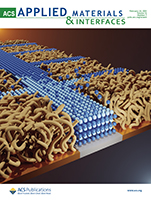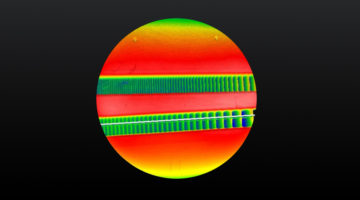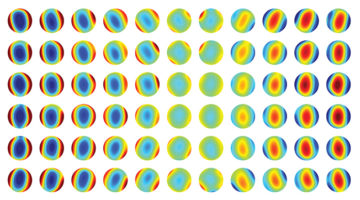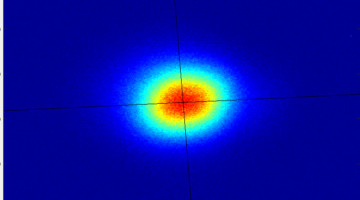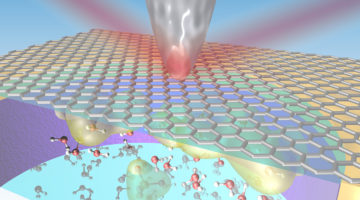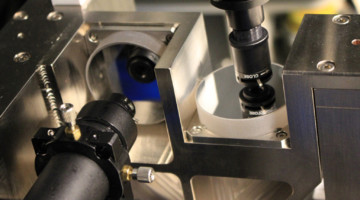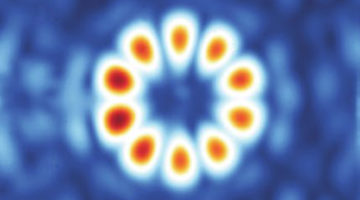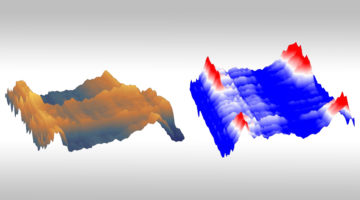This scene depicts the layer-by-layer growth of an inorganic film in a selected area. The alternation of a chemical agent (blue) deposits on a gray substrate to form an inorganic film. A cross-linked organic material (tan) locally inhibits this reaction and prevents film deposition. Furthermore, the pattern-wise cross-linking of this organic film enables nanoscale pattern generation. Read more »
To Speed Discovery, Infrared Microscopy Goes “Off the Grid”
Researchers developed a highly efficient way to collect infrared microscopy data that avoids the use of slow, grid-based raster scans. The method substantially reduces image-acquisition times by autonomously increasing sampling density in regions of interest, facilitating infrared spectromicroscopy of biochemical processes in real time. Read more »
Super-Resolution Measurement of X-Ray Mirrors
ALS researchers, in collaboration with software and nanofabrication small businesses, developed a way to improve the accuracy of instruments that measure the surfaces of x-ray mirrors. The work significantly improves the quality of the data needed for the fabrication and optimal performance of advanced x-ray beamlines and space telescopes. Read more »![]()
![]()
Characterization of EUV Optics using Intrinsic Mask Roughness
Researchers developed an in situ computational technique for measuring aberrations in EUV optics, taking advantage of the surface roughness of photomasks used to transfer circuit patterns onto chips. The technique will prove increasingly valuable in the characterization of coherent light sources and beamline optical systems. Read more »
Machine Learning Helps Stabilize Synchrotron Light
Researchers showed that machine learning can predict noisy fluctuations in the size of beams generated by synchrotron light sources and correct them before they occur. The work solves a decades-old problem and will allow researchers to fully exploit the smaller beams made possible by recent advances in light source technology. Read more »![]()
![]()
Machine Learning Enhances Light-Beam Performance at the Advanced Light Source
Researchers have successfully demonstrated how machine-learning tools can improve beam-size stability via adjustments that largely cancel out these fluctuations—reducing them from a level of a few percent down to 0.4 percent, with submicron precision. The demonstration shows that the technique could be viable for scientific light sources around the globe. Read more »
Infrared Nanospectroscopy at Graphene–Liquid Interfaces
Researchers developed a new infrared approach to probing the first few molecular layers of a liquid in contact with a graphene electrode under operating conditions. The work offers a new way to study the interfaces that are key to understanding batteries, corrosion, and other bio- and electrochemical phenomena. Read more »![]()
![]()
Mirror, Mirror, in the Optimal Spot
Researchers have developed a fast, systematic way to get the best performance out of x-ray mirrors by optimizing their positioning in beamlines. The system does in a day what used to take many days, by combining precise surface metrology with computer analysis of the optimal alignment of a mirror in a beamline. Read more »
A New Twist in Soft X-Ray Beams
Visible-light beams with orbital angular momentum (OAM) have been used in applications ranging from communications and imaging to particle manipulation. Now, researchers have generated high-quality OAM beams in the soft x-ray regime, with intriguing possibilities for future use at high-coherence, diffraction-limited light sources. Read more »
Expanding the Infrared Nanospectroscopy Window
An innovative infrared-light probe with nanoscale spatial resolution has been expanded to cover previously inaccessible far-infrared wavelengths. The ability to investigate heterogeneous materials at nanometer scales and far-infrared energies will benefit a wide range of fields, from condensed matter physics to biology. Read more »![]()
![]()
